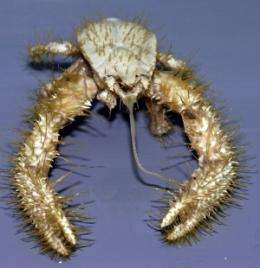December 29, 2011 report
British oceanographers find new species in Indian Ocean hydrothermal vents

(PhysOrg.com) -- A research team sailing on the vessel James Cook has been studying the unique habitat surrounding deep sea vents in the Indian Ocean far off the south-east coast of Africa. The vents, created by under-the-sea-floor volcanic activity, spew black cloudy liquid and create a hot hostile environment. One of them, known as the Dragon Vent, was the main focus of cameras fixed to an aquatic robot that captured the existence of some of the exotic animals that are able to live in the distinctive environment. One of those creatures, a type of yeti crab, may even be a species unknown to science.
The expedition, sponsored by Britain’s Natural Environment Research Council and led by Dr. Jon Copley, a marine biologist, set sail from South Africa early in November and concluded its voyage this past week. During the middle part of that trip, the team sent down a robot called Kiel 6000 which has both cameras and a means for collecting samples of marine life, to the vents to see what sorts of animals might be living down there. Other such ventures to other vents in the Indian Ocean, as well as in other oceans have shown that truly unique types of creatures have evolved that are able to flourish in such a strange part of the planet. What’s not clear, however, is how such creatures manage to move the vast distances between such vents, as the vents, just like volcanoes on land, tend to go dormant between periods of activity.
Other types of sea life found around vents include sea cucumbers, which are long and skinny and are related to sea stars and unique types of snails, shrimp and mussels.
The vents in this latest study, are part of the South West Indian Ridge, and were first noted in 2007 by a team of Chinese researchers. Vents, or fissures in the sea floor, in general were first found to exist back in 1977 and have attracted attention since that time due to the unique life forms that call such areas home, and the fact that such vents tend to create tall mineral spires that look like chimneys which also quite often contain precious metals. It’s the existence of these metals though that could pose problems for the aquatic life as humans are apt to destroy the unique ecosystem in extracting them. The Dragon Vent, for example, is likely to be impacted soon as China has just recently been granted mineral exploration and extraction rights by the body of the United Nations responsible for doling out such permission.
© 2011 PhysOrg.com





















